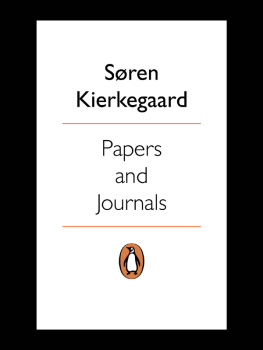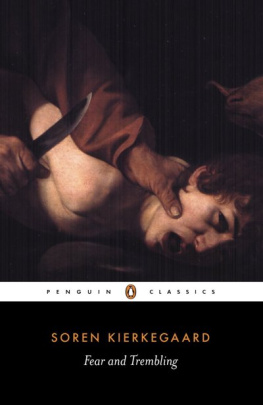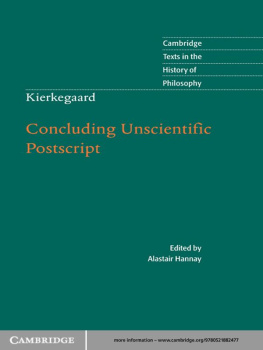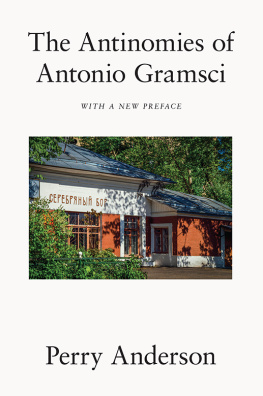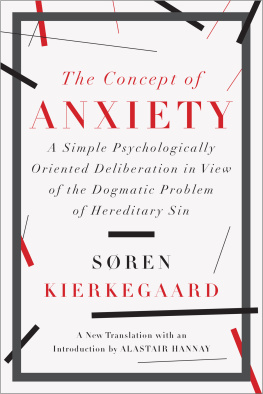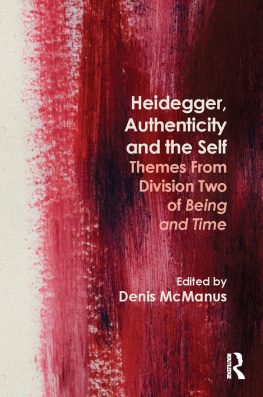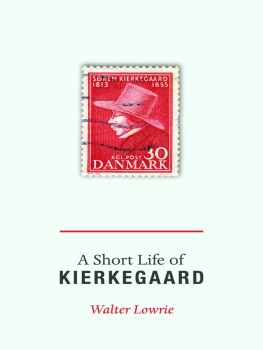
A LITERARY REVIEW
SREN AABYE KIERKEGAARD was born in Copenhagen in 1813, the youngest of seven children. His mother, his sisters and two of his brothers all died before he reached his twenty-first birthday. Kierkegaards childhood was an isolated and unhappy one, clouded by the religious fervour of his father. He was educated at the School of Civic Virtue and went on to enter the university, where he read theology but also studied the liberal arts and science. In all, he spent seven years as a student, gaining a reputation both for his academic brilliance and for his extravagant social life. Towards the end of his university career he started to criticize the Christianity upheld by his father and to look for a new set of values. In 1841 he broke off his engagement to Regine Olsen and devoted himself to his writing. During the next ten years he produced a flood of discourses and no fewer than twelve major philosophical essays, many of them written under noms de plume. Notable are Either/Or (1843), Repetition (1843), Fear and Trembling (1843), Philosophical Fragments (1844), The Concept of Anxiety (1844), Stages on Lifes Way (1845), Concluding Unscientific Postscript (1846) and The Sickness unto Death (1849). By the end of his life Kierkegaard had become an object of public ridicule and scorn, partly because of a feud that he had provoked in 1846 with the satirical Danish weekly The Corsair, partly because of his attacks on the Danish State Church. Few mourned his death in November 1855, but during the early twentieth century his work enjoyed increasing acclaim and he has done much to inspire both modern Protestant theology and existentialism. Today Kierkegaard is attracting increasing attention from philosophers and writers inside and outside the postmodern tradition.
ALASTAIR HANNAY was born to Scottish parents in Plymouth, Devon, in 1932 and educated at the Edinburgh Academy, the University of Edinburgh and University College London. In 1961 he became a resident of Norway, where he is now Emeritus Professor of Philosophy at the University of Oslo. A Fellow of the Royal Society of Edinburgh, he has been a frequent visiting professor at the University of California, at San Diego and at Berkeley. Alastair Hannay has also translated Kierkegaards Fear and Trembling, The Sickness unto Death, Either/Or and Papers andJournals for Penguin Classics. His other publications include Mental Images A Defence, Kierkegaard (Arguments of the Philosophers), Human Consciousness and Kierkegaard: A Biography, as well as articles on diverse themes in philosophical collections and journals. He is the editor of Inquiry.
SREN KIERKEGAARD
A Literary Review
Two Ages, a novel by the author of A Story of Everyday Life, published by J. L. Heiberg, Copenhagen, Reitzel, 1845
Translated with an Introduction and Notes by
ALASTAIR HANNAY
PENGUIN BOOKS
PENGUIN BOOKS
Published by the Penguin Group
Penguin Books Ltd, 80 Strand, London WC2R 0RL , England
Penguin Group (USA) Inc., 375 Hudson Street, New York, New York 10014, USA
Penguin Group (Canada), 90 Eglinton Avenue East, Suite 700, Toronto, Ontario, Canada M4P 2Y3
(a division of Pearson Penguin Canada Inc.)
Penguin Ireland, 25 St Stephens Green, Dublin 2, Ireland (a division of Penguin Books Ltd)
Penguin Group (Australia), 250 Camberwell Road,
Camberwell, Victoria 3124, Australia (a division of Pearson Australia Group Pty Ltd)
Penguin Books India Pvt Ltd, 11 Community Centre, Panchsheel Park, New Delhi 110 017, India
Penguin Group (NZ), cnr Airborne and Rosedale Roads, Albany,
Auckland 1310, New Zealand (a division of Pearson New Zealand Ltd)
Penguin Books (South Africa) (Pty) Ltd, 24 Sturdee Avenue,
Rosebank, Johannesburg 2196, South Africa
Penguin Books Ltd, Registered Offices: 80 Strand, London, WC2R 0RL , England
www.penguin.com
First published 1846
This translation first published 2001
Published in Penguin Classics 2006
Copyright Alastair Hannay, 2001
All rights reserved
The moral right of the author has been asserted
Except in the United States of America, this book is sold subject to the condition that it shall not, by way of trade or otherwise, be lent, re-sold, hired out, or otherwise circulated without the publishers prior consent in any form of binding or cover other than that in which it is published and without a similar condition including this condition being imposed on the subsequent purchaser
ISBN: 978-0-14-195865-1
I would like to dedicate my translation to
HUBERT L. DREYFUS
TRANSLATORS INTRODUCTION
The name Kierkegaard is mostly associated with works by which the Danish author was best known in his lifetime, first and foremost Either/ Or but also other such oddly memorable titles as Fear and Trembling, The Concept of Dread, Philosophical Fragments, Concluding UnscientificPostscript and The Sickness unto Death. What we easily forget is that these and other works appeared under pseudonyms. Why Kierkegaard resorted to pseudonymity is the subject of much speculation, but he himself provided one quite plausible explanation. In a short work, ThePoint of View for My Activity as an Author, published after his death, he says in effect that the pseudonymity was designed to let the works express views of life without the reader being led to think they might be the actual views of the author. His own task as a writer Kierkegaard took to be that of promoting in individual readers a sense, first, of a need for such life-views and, second, of the ways in which certain prevalent life-views, the kind he called aesthetic, were inadequate to the individuals true needs. The task, as he saw it, was to begin with the inadequate views and convey somehow the ways in which they were deficient. More generally, his project was aimed at the cultivation in the reader of what one pseudonymous author in particular, Johannes Climacus, calls inwardness (Inderlighed). This is not, as the English word suggests, a self-centred absorption in the states of ones own mind or soul, but an engagement by the whole person in lifes tasks.
It need come as no surprise, then, to those who know Kierkegaard only through his pseudonyms, to find how sharp an eye the poet-philosopher of inwardness has for the ways in which people fail to engage themselves in this way. More surprising, perhaps, is the skill with which, in A Literary Review, he relates such failure on the part of the individual to features of society and cultural life at large. The work includes one of the most startling pieces of cultural analysis to be found anywhere.
A Literary Review was published in Copenhagen on 30 March 1846. Kierkegaard had begun writing it while waiting for proofs of the work with which he intended to mark the end of his pseudonymous authorship, the aptly named Concluding Unscientific Postscript. That authorship, of a series of works starting with Either/Or, had occupied him for four intensive years during which he also wrote a series of signed works described as edifying and Christian discourses. The sequence of events which turned Sren Aabye Kierkegaard (the surname an earlier spelling of the Danish for graveyard, Kirkegrd) to full-time authorship began in 1837 when he met Regine Olsen, daughter of a Copenhagen dignitary. Regine was then fourteen years old. Their later engagement and his breaking it off were to provide the focus of much of his writing. The following year Kierkegaards father, Michael Pedersen Kierkegaard, died, aged eighty-one (Sren was then twenty-five). The death led Kierkegaard, after ten years as a student, finally to complete his university exams and face the future.
Next page

